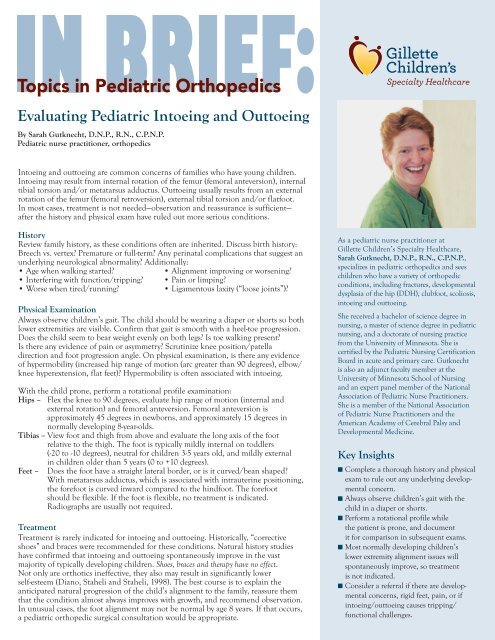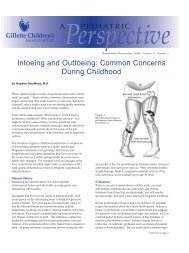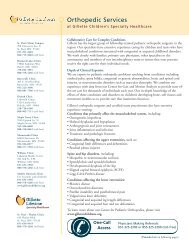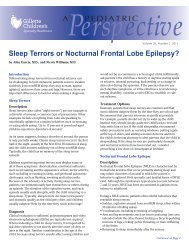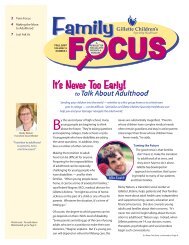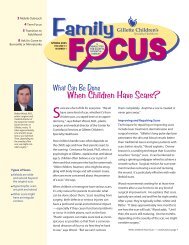Evaluating Pediatric Intoeing and Outtoeing - Gillette Children's ...
Evaluating Pediatric Intoeing and Outtoeing - Gillette Children's ...
Evaluating Pediatric Intoeing and Outtoeing - Gillette Children's ...
Create successful ePaper yourself
Turn your PDF publications into a flip-book with our unique Google optimized e-Paper software.
<strong>Evaluating</strong> <strong>Pediatric</strong> <strong>Intoeing</strong> <strong>and</strong> <strong>Outtoeing</strong>By Sarah Gutknecht, D.N.P., R.N., C.P.N.P.<strong>Pediatric</strong> nurse practitioner, orthopedics<strong>Intoeing</strong> <strong>and</strong> outtoeing are common concerns of families who have young children.<strong>Intoeing</strong> may result from internal rotation of the femur (femoral anteversion), internaltibial torsion <strong>and</strong>/or metatarsus adductus. <strong>Outtoeing</strong> usually results from an externalrotation of the femur (femoral retroversion), external tibial torsion <strong>and</strong>/or flatfoot.In most cases, treatment is not needed—observation <strong>and</strong> reassurance is sufficient—after the history <strong>and</strong> physical exam have ruled out more serious conditions.HistoryReview family history, as these conditions often are inherited. Discuss birth history:Breech vs. vertex? Premature or full-term? Any perinatal complications that suggest anunderlying neurological abnormality? Additionally:• Age when walking started?• Alignment improving or worsening?• Interfering with function/tripping? • Pain or limping?• Worse when tired/running?• Ligamentous laxity (“loose joints”)?Physical ExaminationAlways observe children’s gait. The child should be wearing a diaper or shorts so bothlower extremities are visible. Confirm that gait is smooth with a heel-toe progression.Does the child seem to bear weight evenly on both legs? Is toe walking present?Is there any evidence of pain or asymmetry? Scrutinize knee position/patelladirection <strong>and</strong> foot progression angle. On physical examination, is there any evidenceof hypermobility (increased hip range of motion (arc greater than 90 degrees), elbow/knee hyperextension, flat feet)? Hypermobility is often associated with intoeing.With the child prone, perform a rotational profile examination:Hips – Flex the knee to 90 degrees, evaluate hip range of motion (internal <strong>and</strong>external rotation) <strong>and</strong> femoral anteversion. Femoral anteversion isapproximately 45 degrees in newborns, <strong>and</strong> approximately 15 degrees innormally developing 8-year-olds.Tibias – View foot <strong>and</strong> thigh from above <strong>and</strong> evaluate the long axis of the footrelative to the thigh. The foot is typically mildly internal on toddlers(-20 to -10 degrees), neutral for children 3-5 years old, <strong>and</strong> mildly externalin children older than 5 years (0 to +10 degrees).Feet – Does the foot have a straight lateral border, or is it curved/bean shaped?With metatarsus adductus, which is associated with intrauterine positioning,the forefoot is curved inward compared to the hindfoot. The forefootshould be flexible. If the foot is flexible, no treatment is indicated.Radiographs are usually not required.TreatmentTreatment is rarely indicated for intoeing <strong>and</strong> outtoeing. Historically, “correctiveshoes” <strong>and</strong> braces were recommended for these conditions. Natural history studieshave confirmed that intoeing <strong>and</strong> outtoeing spontaneously improve in the vastmajority of typically developing children. Shoes, braces <strong>and</strong> therapy have no effect.Not only are orthotics ineffective, they also may result in significantly lowerself-esteem (Diano, Staheli <strong>and</strong> Staheli, 1998). The best course is to explain theanticipated natural progression of the child’s alignment to the family, reassure themthat the condition almost always improves with growth, <strong>and</strong> recommend observation.In unusual cases, the foot alignment may not be normal by age 8 years. If that occurs,a pediatric orthopedic surgical consultation would be appropriate.As a pediatric nurse practitioner at<strong>Gillette</strong> Children’s Specialty Healthcare,Sarah Gutknecht, D.N.P., R.N., C.P.N.P.,specializes in pediatric orthopedics <strong>and</strong> seeschildren who have a variety of orthopedicconditions, including fractures, developmentaldysplasia of the hip (DDH), clubfoot, scoliosis,intoeing <strong>and</strong> outtoeing.She received a bachelor of science degree innursing, a master of science degree in pediatricnursing, <strong>and</strong> a doctorate of nursing practicefrom the University of Minnesota. She iscertified by the <strong>Pediatric</strong> Nursing CertificationBoard in acute <strong>and</strong> primary care. Gutknechtis also an adjunct faculty member at theUniversity of Minnesota School of Nursing<strong>and</strong> an expert panel member of the NationalAssociation of <strong>Pediatric</strong> Nurse Practitioners.She is a member of the National Associationof <strong>Pediatric</strong> Nurse Practitioners <strong>and</strong> theAmerican Academy of Cerebral Palsy <strong>and</strong>Developmental Medicine.Key Insights■ Complete a thorough history <strong>and</strong> physicalexam to rule out any underlying developmentalconcern.■ Always observe children’s gait with thechild in a diaper or shorts.■ Perform a rotational profile whilethe patient is prone, <strong>and</strong> documentit for comparison in subsequent exams.■ Most normally developing children’slower extremity alignment issues willspontaneously improve, so treatmentis not indicated.■ Consider a referral if there are developmentalconcerns, rigid feet, pain, or ifintoeing/outtoeing causes tripping/functional challenges.
November 2013 Volume 2, Number 3Managing AdolescentIdiopathic Scoliosis200 University Ave. E.St. Paul, MN 55101651-291-2848www.gillettechildrens.orgADDRESS SERVICEREQUESTEDNonprofitOrganizationU.S. PostageP A I DTwin Cities, MNPermit No. 5388To make a referral, call651-325-2200 or855-325-2200 (toll-free).200 University Ave. E.St. Paul, MN 55101651-325-2200 or 855-325-2200 (toll-free)www.gillettechildrens.orgEditor - Paul FioreWriter - Ellen ShrinerGraphic Designer - Kim GoodnessPhotographers - Anna Bittner,Paul DeMarchiCopyright 2013, <strong>Gillette</strong> Children’sSpecialty Healthcare.About InBriefInBrief has been developedby pediatric orthopedicspecialists at <strong>Gillette</strong>Children’s SpecialtyHealthcare as a resourcefor primary care providers.If you have comments orquestions, please contactPaul Fiore, M.B.A., F.A.C.H.E.,program manager, Center for<strong>Pediatric</strong> Orthopedics, atpfiore@gillettechildrens.com.<strong>Pediatric</strong> <strong>Intoeing</strong> <strong>and</strong> <strong>Outtoeing</strong>■ In-toeing■ <strong>Intoeing</strong>■ Out-toeing■ <strong>Outtoeing</strong>Internal ■tibial torsion .■ FemoralanteversionTo subscribe to or unsubscribefrom InBrief, please send anemail to Publications@gillettechildrens.com.External ■thigh-foot .angle (TFA) .■ Internalthigh-footangle (TFA)


